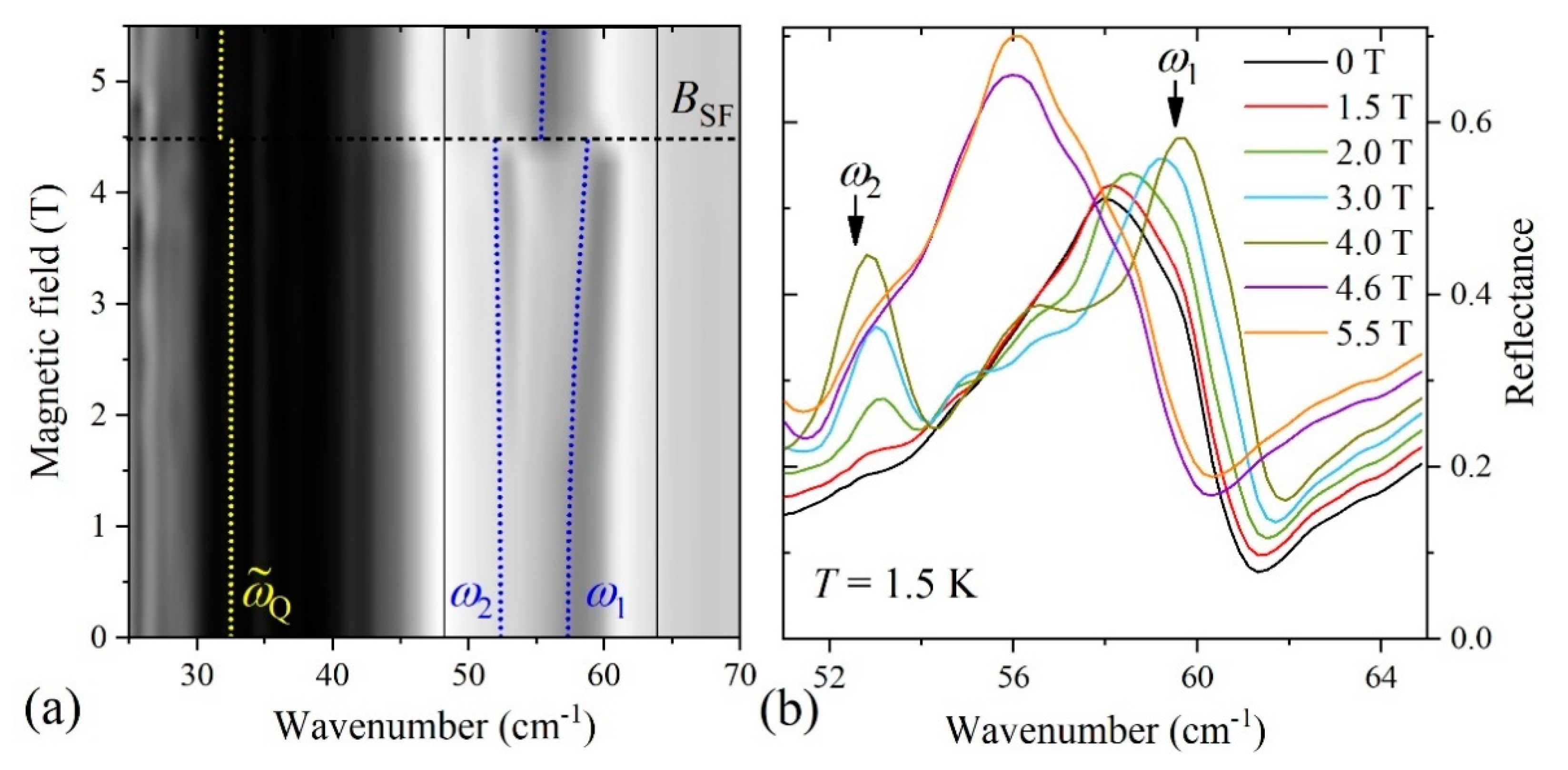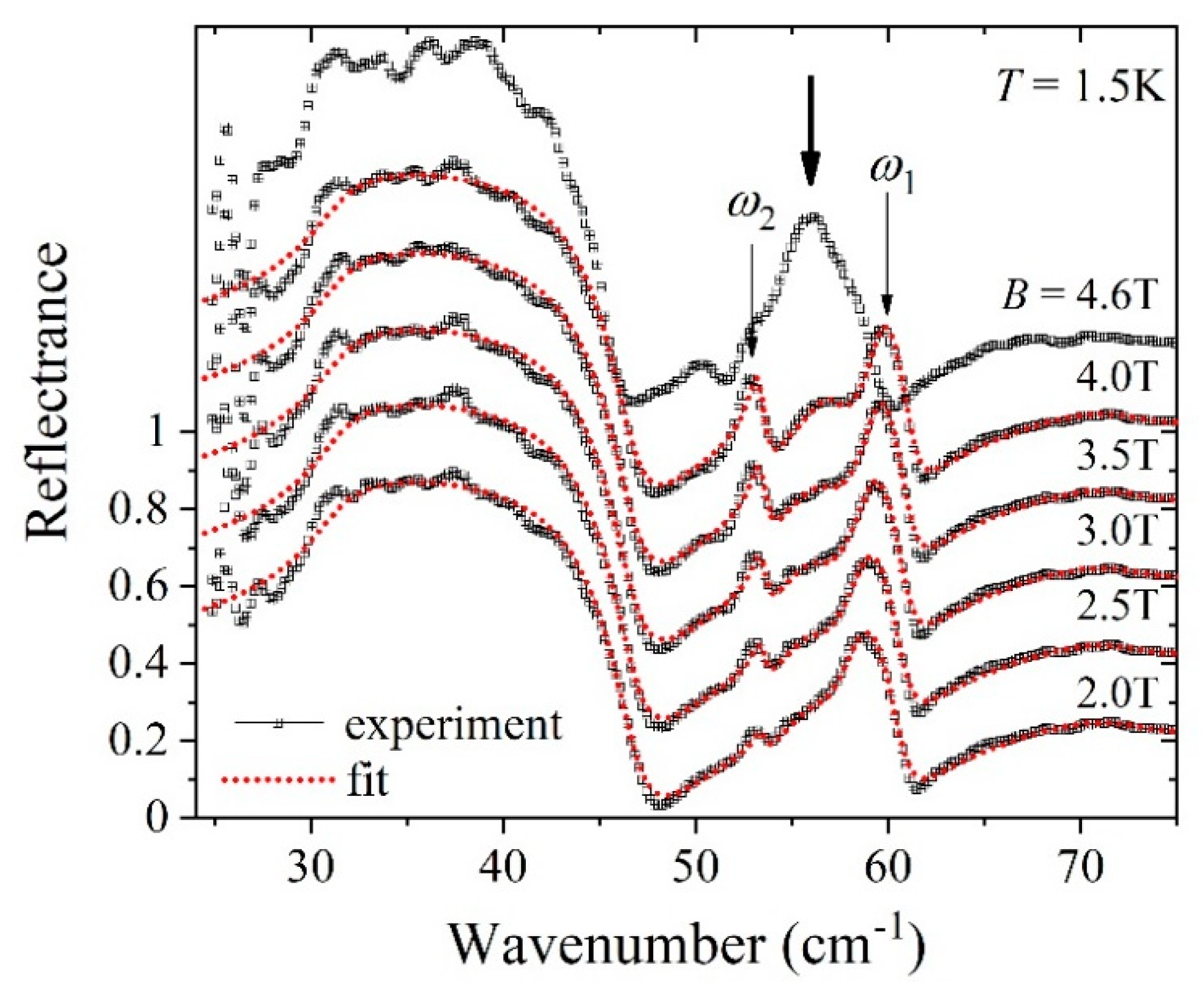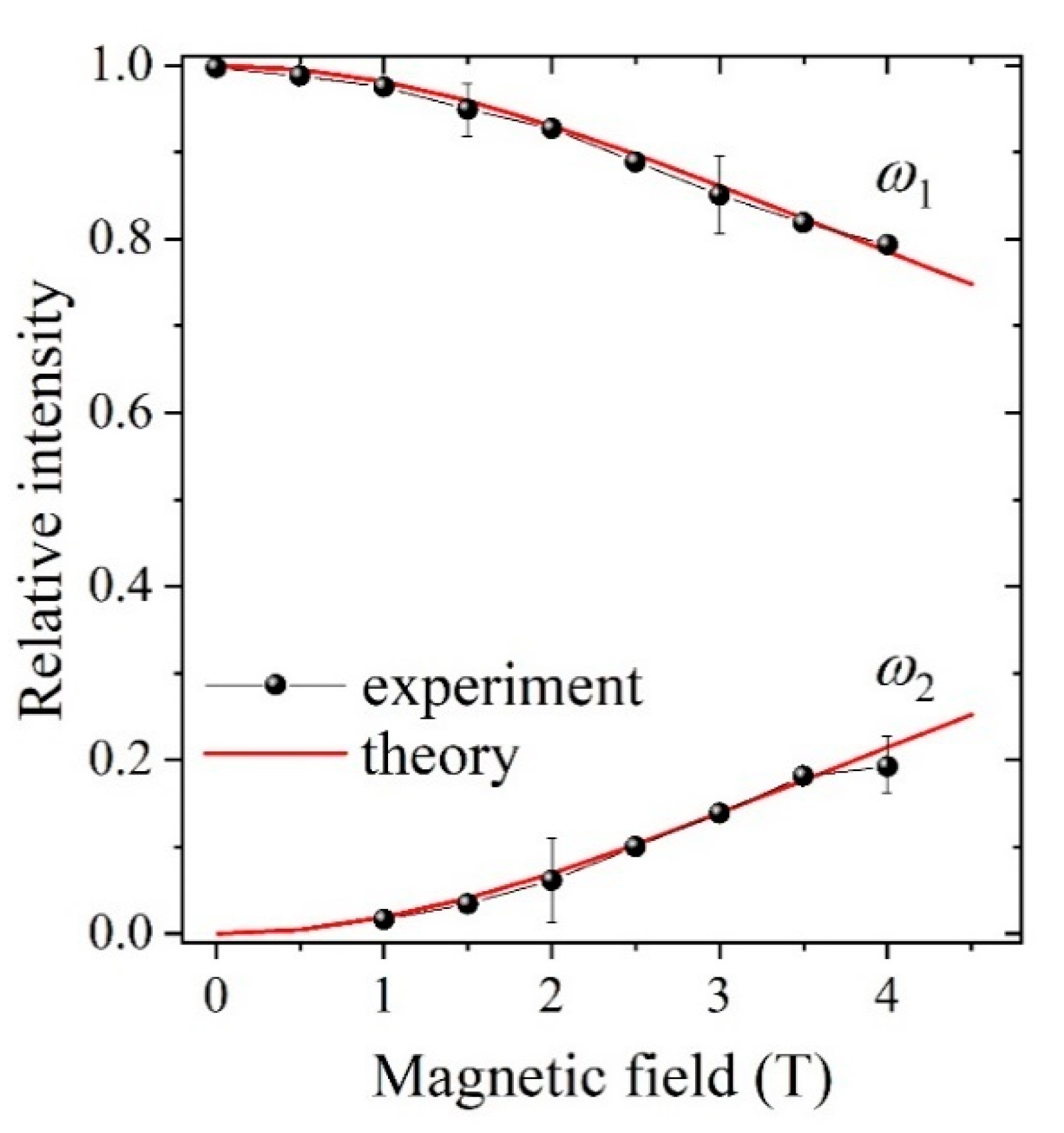Magnetic-Field-Tunable Intensity Transfer from Optically Active Phonons to Crystal-Field Excitations in the Reflection Spectra of the PrFe3(BO3)4 Antiferromagnet
Abstract
:1. Introduction
2. Structure and Properties of PrFe3(BO3)4 Crystals
3. Experimental Results
4. Theory
5. Conclusions
Author Contributions
Funding
Institutional Review Board Statement
Informed Consent Statement
Data Availability Statement
Conflicts of Interest
References
- Spaldin, N.A.; Ramesh, R. Advances in magnetoelectric multiferroics. Nat. Mater. 2019, 18, 203–212. [Google Scholar] [CrossRef] [PubMed]
- Liang, X.; Chen, H.; Sun, N.X. Magnetoelectric materials and devices. APL Mater. 2021, 9, 041114. [Google Scholar] [CrossRef]
- Pyatakov, A.P.; Zvezdin, A.K. Magnetoelectric and multiferroic media. Physics-Uspekhi 2012, 55, 557. [Google Scholar] [CrossRef]
- Khomskii, D. Classifying multiferroics: Mechanisms and effects. Physics 2009, 2, 20. [Google Scholar] [CrossRef] [Green Version]
- Hampel, A.; Liu, P.; Franchini, C.; Ederer, C. Energetics of the coupled electronic–structural transition in the rare-earth nickelates. NPJ Quantum Mater. 2019, 4, 5. [Google Scholar] [CrossRef]
- Man, H.; Shi, Z.; Xu, G.; Xu, Y.; Chen, X.; Sullivan, S.; Zhou, J.; Xia, K.; Shi, J.; Dai, P. Direct observation of magnon-phonon coupling in yttrium iron garnet. Phys. Rev. B 2017, 96, 100406. [Google Scholar] [CrossRef] [Green Version]
- Yildirim, T.; Vergara, L.I.; ĺṅiguez, J.; Musfeldt, J.L.; Harris, A.B.; Rogado, N.; Cava, R.J.; Yen, F.; Chaudhury, R.P.; Lorenz, B. Phonons and magnetoelectric interactions in Ni3V2O8. J. Phys. Condens. Matter 2008, 20, 434214. [Google Scholar] [CrossRef]
- Kang, T.D.; Standard, E.; Ahn, K.H.; Sirenko, A.A.; Carr, G.L.; Park, S.; Choi, Y.J.; Ramazanoglu, M.; Kiryukhin, V.; Cheong, S.-W. Coupling between Magnon and Ligand-Field Excitations in Magnetoelectric Garnet. Phys. Rev. B 2010, 82, 014414. [Google Scholar] [CrossRef] [Green Version]
- Pimenov, A.; Mukhin, A.A.; Ivanov, V.Y.; Travkin, V.D.; Balbashov, A.M.; Loidl, A. Possible evidence for electromagnons in multiferroic manganites. Nat. Phys. 2006, 2, 97–100. [Google Scholar] [CrossRef] [Green Version]
- Szaller, D.; Shuvaev, A.; Mukhin, A.A.; Kuzmenko, A.M.; Pimenov, A. Controlling of Light with Electromagnons. Phys. Sci. Rev. 2020, 5, 20190055. [Google Scholar] [CrossRef] [Green Version]
- Boldyrev, K.N.; Stanislavchuk, T.N.; Sirenko, A.A.; Bezmaternykh, L.N.; Popova, M.N. Coupling between Phonon and Crystal-Field Excitations in Multiferroic. Phys. Rev. B 2014, 90, 121101. [Google Scholar] [CrossRef] [Green Version]
- Boldyrev, K.N.; Stanislavchuk, T.N.; Sirenko, A.A.; Kamenskyi, D.; Bezmaternykh, L.N.; Popova, M.N. Bifurcations of Coupled Electron-Phonon Modes in an Antiferromagnet Subjected to a Magnetic Field. Phys. Rev. Lett. 2017, 118, 167203. [Google Scholar] [CrossRef] [PubMed] [Green Version]
- Popova, M.N.; Boldyrev, K.N. New Effects of the Electron-Phonon Interaction in Dielectrics (50th Anniversary of the Institute of Spectroscopy, Russian Academy of Sciences). Physics-Uspekhi 2019, 62, 275–281. [Google Scholar] [CrossRef]
- Kadomtseva, A.M.; Popov, Y.F.; Vorob’ev, G.P.; Pyatakov, A.P.; Krotov, S.S.; Kamilov, K.I.; Ivanov, V.Y.; Mukhin, A.A.; Zvezdin, A.K.; Kuz’menko, A.M.; et al. Magnetoelectric and Magnetoelastic Properties of Rare-Earth Ferroborates. Low Temp. Phys. 2010, 36, 511–521. [Google Scholar] [CrossRef]
- Kuzmenko, A.M.; Szaller, D.; Kain, T.; Dziom, V.; Weymann, L.; Shuvaev, A.; Pimenov, A.; Mukhin, A.A.; Ivanov, V.Y.; Gudim, I.A.; et al. Switching of Magnons by Electric and Magnetic Fields in Multiferroic Borates. Phys. Rev. Lett. 2018, 120, 027203. [Google Scholar] [CrossRef] [Green Version]
- Nakamura, S.; Masuda, T.; Ohgushi, K.; Katsufuji, T. Mössbauer Study of Rare-Earth Ferroborate NdFe3(BO3)4. J. Phys. Soc. Jap. 2020, 89, 084703. [Google Scholar] [CrossRef]
- Golosovsky, I.V.; Mukhin, A.A.; Skumryev, V.; Boehm, M.; Schmidt, W.; Regnault, L.-P.; Gudim, I.A. Magnetic Excitations and Exchange Interactions in the Substituted Multiferroics (Nd, Tb)Fe3(BO3)4 Revealed by Inelastic Neutron Scattering. Phys. Rev. B 2021, 103, 214412. [Google Scholar] [CrossRef]
- Gerlinger, H.; Schaack, G. Crystal-Field States of the Ce3+ ion in CeF3: A Demonstration of Vibronic Interaction in Ionic Rare-Earth Compounds. Phys. Rev. B 1986, 33, 7438–7450. [Google Scholar] [CrossRef] [PubMed]
- Leonyuk, N.I.; Leonyuk, L.I. Growth and Characterization of RM3(BO3)4 Crystals. Prog. Cryst. Growth Charact. Mater. 1995, 31, 179–278. [Google Scholar] [CrossRef]
- Ritter, C.; Vorotynov, A.; Pankrats, A.; Petrakovskii, G.; Temerov, V.; Gudim, I.; Szymczak, R. Magnetic Structure in Iron Borates RFe3(BO3)4 (R = Er, Pr): A Neutron Diffraction and Magnetization Study. J. Phys. Condens. Matter 2010, 22, 206002. [Google Scholar] [CrossRef]
- Klimin, S.A.; Fausti, D.; Meetsma, A.; Bezmaternykh, L.N.; van Loosdrecht, P.H.M.; Palstra, T.T.M. Evidence for Differentiation in the Iron-Helicoidal Chain in GdFe3(BO3)4. Acta Crystallogr. Sect. B Struct. Sci. 2005, 61, 481–485. [Google Scholar] [CrossRef] [Green Version]
- Popova, M.N.; Stanislavchuk, T.N.; Malkin, B.Z.; Bezmaternykh, L.N. Breaking of the Selection Rules for Optical Transitions in the Dielectric PrFe3(BO3)4 Crystal by a Praseodymium-Iron Exchange Interaction. Phys. Rev. Lett. 2009, 102, 187403. [Google Scholar] [CrossRef] [PubMed]
- Popova, M.N.; Stanislavchuk, T.N.; Malkin, B.Z.; Bezmaternykh, L.N. Optical Spectroscopy of PrFe3(BO3)4: Crystal-Field and Anisotropic Pr-Fe Exchange Interactions. Phys. Rev. B 2009, 80, 195101. [Google Scholar] [CrossRef]
- Kadomtseva, A.M.; Popov, Y.F.; Vorob’ev, G.P.; Mukhin, A.A.; Ivanov, V.Y.; Kuz’menko, A.M.; Bezmaternykh, L.N. Influence of the Ground State of the Pr3+ Ion on Magnetic and Magnetoelectric Properties of the PrFe3(BO3)4 Multiferroic. JETP Lett. 2008, 87, 39–44. [Google Scholar] [CrossRef]
- Kostyuchenko, N.V.; Popov, A.I.; Zvezdin, A.K. Features of Magnetic and Magnetoelectric Properties of Rare-Earth Multiferroic PrFe3(BO3)4 with the Singlet Ground State. Phys. Solid State 2012, 54, 1591–1597. [Google Scholar] [CrossRef]
- Chernyshev, V.A.; Nikiforov, A.E.; Petrov, V.P.; Serdtsev, A.V.; Kashchenko, M.A.; Klimin, S.A. Structure and Lattice Dynamics of Rare-Earth Ferroborate Crystals: Ab Initio Calculation. Phys. Solid State 2016, 58, 1642–1650. [Google Scholar] [CrossRef]
- Kuzmenko, A.B. Kramers–Kronig Constrained Variational Analysis of Optical Spectra. Rev. Sci. Instrum. 2005, 76, 083108. [Google Scholar] [CrossRef] [Green Version]
- Guide to RefFIT Software to Fit Optical Spectra. Available online: https://reffit.ch/wp-content/uploads/2018/10/Manual.pdf (accessed on 25 February 2022).
- Sethi, A.; Slimak, J.E.; Kolodiazhnyi, T.; Cooper, S.L. Emergent Vibronic Excitations in the magnetodielectric regime of Ce2O3. Phys. Rev. Lett. 2019, 122, 177601. [Google Scholar] [CrossRef] [PubMed] [Green Version]



Publisher’s Note: MDPI stays neutral with regard to jurisdictional claims in published maps and institutional affiliations. |
© 2022 by the authors. Licensee MDPI, Basel, Switzerland. This article is an open access article distributed under the terms and conditions of the Creative Commons Attribution (CC BY) license (https://creativecommons.org/licenses/by/4.0/).
Share and Cite
Boldyrev, K.N.; Malkin, B.Z.; Popova, M.N. Magnetic-Field-Tunable Intensity Transfer from Optically Active Phonons to Crystal-Field Excitations in the Reflection Spectra of the PrFe3(BO3)4 Antiferromagnet. Crystals 2022, 12, 392. https://doi.org/10.3390/cryst12030392
Boldyrev KN, Malkin BZ, Popova MN. Magnetic-Field-Tunable Intensity Transfer from Optically Active Phonons to Crystal-Field Excitations in the Reflection Spectra of the PrFe3(BO3)4 Antiferromagnet. Crystals. 2022; 12(3):392. https://doi.org/10.3390/cryst12030392
Chicago/Turabian StyleBoldyrev, Kirill N., Boris Z. Malkin, and Marina N. Popova. 2022. "Magnetic-Field-Tunable Intensity Transfer from Optically Active Phonons to Crystal-Field Excitations in the Reflection Spectra of the PrFe3(BO3)4 Antiferromagnet" Crystals 12, no. 3: 392. https://doi.org/10.3390/cryst12030392
APA StyleBoldyrev, K. N., Malkin, B. Z., & Popova, M. N. (2022). Magnetic-Field-Tunable Intensity Transfer from Optically Active Phonons to Crystal-Field Excitations in the Reflection Spectra of the PrFe3(BO3)4 Antiferromagnet. Crystals, 12(3), 392. https://doi.org/10.3390/cryst12030392





